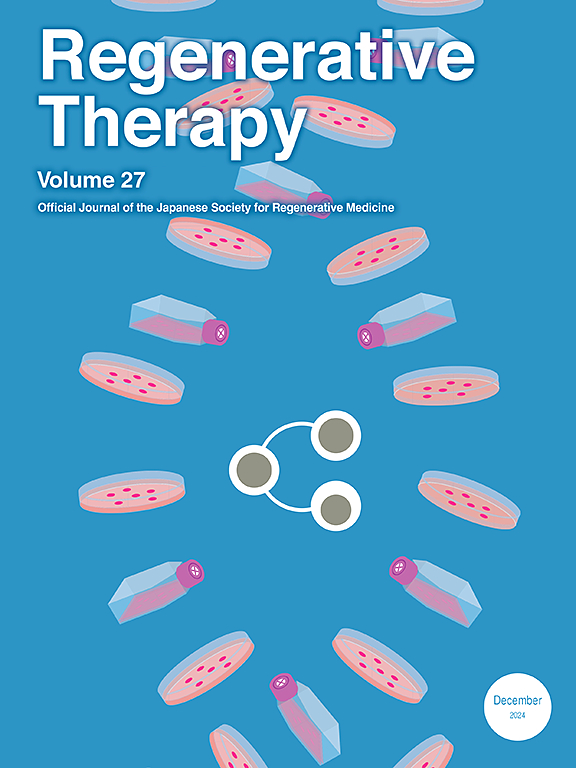Harnessing stromal vascular fraction-based therapies for wound healing: Mechanisms, synergies, and clinical translation
IF 3.5
3区 环境科学与生态学
Q3 CELL & TISSUE ENGINEERING
引用次数: 0
Abstract
Wound healing remains a major challenge in contemporary medicine, particularly with the increasing incidence of chronic wounds, such as those associated with diabetes and thermal injuries. Current treatments such as vacuum sealing drainage, topical therapies, and autologous skin grafting are limited by issues like poor therapeutic efficacy, frequent dressing changes, and immune responses. Cell-based therapies have shown promise but are hindered by single-cell type limitations and hostile wound microenvironments. The stromal vascular fraction (SVF) has emerged as a potential solution, where the enzymatic digestion (E-SVF) contains various cell types, including adipose-derived stem cells (ADSCs), endothelial cells, and fibroblasts, while mechanical digestion (M-SVF) introduces additional extracellular matrix (ECM), termed stromal vascular matrix (SVM). This review systematically evaluates the applications of SVF and SVM in wound healing. SVF promotes wound repair through proangiogenic, immunomodulatory, and ECM remodeling effects. When combined with platelet-rich plasma (PRP) or biomaterials, its efficacy is further enhanced through the synergistic regulation of inflammation and angiogenesis. SVM, with preserved ECM, and SVM-conditioned medium (SVM-CM), rich in growth factors, demonstrate superior wound healing capabilities compared to conventional SVF. Despite the challenges posed by impaired viability and function of aged SVF-derived ADSCs and the low mechanical properties of SVM, emerging technologies, such as 3D cell cultures to enhance stemness and the integration of other biomaterials to improve mechanical strength, offer promising solutions. This review highlights the potential of SVF as an autologous, multifunctional strategy to address unmet needs in wound healing and provides insights into future clinical applications and research directions.
利用基质血管分块治疗伤口愈合:机制、协同作用和临床转化
伤口愈合仍然是当代医学的一个主要挑战,特别是随着慢性伤口的发病率增加,例如与糖尿病和热损伤相关的伤口。目前的治疗方法如真空密封引流、局部治疗和自体皮肤移植等,由于治疗效果差、换药频繁和免疫反应等问题而受到限制。细胞为基础的治疗已经显示出希望,但单细胞类型的限制和不利的伤口微环境阻碍。基质血管部分(SVF)已成为一种潜在的解决方案,其中酶消化(E-SVF)包含各种细胞类型,包括脂肪来源的干细胞(ADSCs),内皮细胞和成纤维细胞,而机械消化(M-SVF)引入额外的细胞外基质(ECM),称为基质血管基质(SVM)。本文对SVF和SVM在创面愈合中的应用进行了系统评价。SVF通过促进血管生成、免疫调节和ECM重塑作用促进伤口修复。当与富血小板血浆(PRP)或生物材料联合使用时,通过协同调节炎症和血管生成,其疗效进一步增强。与传统的SVF相比,保留ECM的SVM和富含生长因子的SVM条件培养基(SVM- cm)显示出更好的伤口愈合能力。尽管衰老的svf衍生ADSCs的活力和功能受损以及SVM的低力学性能带来了挑战,但新兴技术,如3D细胞培养增强干性和整合其他生物材料以提高机械强度,提供了有希望的解决方案。这篇综述强调了SVF作为一种自体的、多功能的策略来解决伤口愈合中未被满足的需求的潜力,并为未来的临床应用和研究方向提供了见解。
本文章由计算机程序翻译,如有差异,请以英文原文为准。
求助全文
约1分钟内获得全文
求助全文
来源期刊

Regenerative Therapy
Engineering-Biomedical Engineering
CiteScore
6.00
自引率
2.30%
发文量
106
审稿时长
49 days
期刊介绍:
Regenerative Therapy is the official peer-reviewed online journal of the Japanese Society for Regenerative Medicine.
Regenerative Therapy is a multidisciplinary journal that publishes original articles and reviews of basic research, clinical translation, industrial development, and regulatory issues focusing on stem cell biology, tissue engineering, and regenerative medicine.
 求助内容:
求助内容: 应助结果提醒方式:
应助结果提醒方式:


